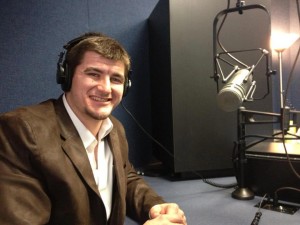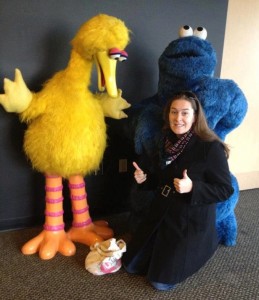[Editor’s note: This is the second guest post from our intrepid graduate student teachers and heroes of scientific awesomeness Lindsey Kraatz, Sam Lake, Daniel Maxey, and Stephanie Salisbury. This post is a companion to their interview on NPR, which you can listen to here: With Good Reason. Thanks for making us all seem cooler. Y’all rock!]
When we wrote our last post “WOW – did you see them? they must be scientists”, we were excited just to share some preliminary results from a small, but exciting (to us anyway) side project that we conducted as we began working with local middle and high school students as a part of the VIMS “Perfect” NSF GK-12 Program. The Draw a Scientist Test (DAST) wasn’t a new idea by any means — Chambers had performed his original test in 1983 and sampled over 4800 students. However, our goal was a little different… we were conducting this experiment to see how our interaction with students over the course of a school year would change their perceptions of scientists and science in general. The feedback we have received over the past year and a half has been nothing short of inspiring. Today as we literally walked down Sesame Street to enter the NPR/PBS studios to do our first radio interview it made us all reflect on how unique, interesting, and just plain fun this study and experience has been.
Here’s what we’ve been doing with the DAST results, what our experience was like interviewing for the NPR show With Good Reason, and what’s coming up next.
What we found out in our “Draw a Scientist” (DAST) project
The results from this “small” side project have now been presented at the National NSF GK-12 conference, the Coastal and Estuarine Research Federation biannual meeting, and at an Atlantic Estuarine Research Society conference; reaching approximately 1000 teachers, scientists, and graduate students! While we don’t want to share all of our findings before we publish the results we did want to include a small sample of what is to come.
A Few Comments on the Radio Interview
Lindsey – Throughout graduate school, you see your professors and mentors get interviewed and have their work shown in documentaries, and you begin to ask “Will I ever do anything exciting enough that someone other than my family and colleagues would want hear about?” When we got a call to ask if we would be interested in sharing our story for our DAST project, I almost fell out of my chair. What a thrill! I was ecstatic about the opportunity to discuss our project, science, and STEM education with three of my closest friends on NPR. Daniel, Sam, Stephanie and I all crammed into a small sound booth and had a wonderful time talking with the crew of With Good Reason. It was great that the four of us were together in order to alleviate any jitters and nerves we may have had before the interview started. In the end, our 45-minute interview will be pared down to approximately 5 minutes so it will be interesting to see what sticks in the final copy.
For any other young scientists who are interested in getting your work out to the media, the best thing you can do is network and fill in people who are interested, whether it be at a national conference, blog post, or a departmental happy hour. NPR found us because of our initial SeaMonster blog post [Editor’s note: YEAH MAN!]. However, before making any official public comments, make sure you keep in touch with your institution’s Director of Communication for approval and suggestions. He/she will be able to help pitch your story and give you tips on how effectively communicate your study to the public (Thanks Dave).
Sam – As a scientist (especially a younger scientist) I think you wonder “will my work be cool enough to make it on NPR one day?” I could have never imagined a better topic or a better group of collaborators to share the microphone with when that day came.
Since it had been a while since any of us had presented the DAST results or worked on the manuscript, I think the initial email from the show caught us all a little off guard. However, somewhere between telling the producer what we had done for the project and snapping pictures of ourselves with Cookie Monster before the show it all became real. The interview process went great and my advice to other young scientists getting ready for an interview would be to 1) take it slow and enjoy the whole thing 2) bring in images and figures to look at as you talk, they come in really handy when you need to describe or explain something in detail 3) have a copy of your “facts and results” handy but don’t try to plan every word that you want to say. While I am sure there are a number of other things I could add, I’ll end with “just have fun”.

Daniel – When I entered the VIMS Gk-12 PERFECT fellowship I thought to myself, “Wow! The impression these students will have of science and scientists will be heavily influenced by my presence in their classroom.” A sobering thought in its own right, however I never expected to collect data that would measure that influence. Fast-forward two years and here we were sitting in a radio studio announcing just how strong our (Gk-12 Fellows) influence was. I felt like a fish-out-of-water, a bit nervous, but excited to discuss the project again with the other authors and tell the world (at least the “With Good Reason” affiliated world) about our study. If one can look past my crude movements around the microphone and shaky voice they may hear excitement pervading that small recording booth coming from us 4 research partners.

Stephanie – My initial thoughts were- “We were on the radio. Radio waves are transmitted into outer space. We might be heard in outer space someday!” Those thoughts didn’t even take into account the interview being posted on the internet, which makes it accessible to the entire world instantaneously (the outer space thing will probably take a while). If you want to get your message out, it seems like the internet is a great place to start. I had no idea that so many people would be interested in a little project the four of us did initially for our own curiosity. I hope that our results and exposure will inspire others to do more with science, do more for science and do more because of science. Science has always been and will forever be the thing I am most passionate about; and now more than ever, our nation needs to see science for what it is, not what they believe it is- and I think this exposure is going to help in that undertaking.
Our episode onWith Good Reason is being broadcast in Washington DC, Virginia, Maryland, Tennessee, Georgia, Alaska, California, and Michigan on February 9, 2013. For more information, or to download a podcast of the show please see: http://withgoodreasonradio.org/
What’s Next?!?!
After an exciting year that included fellowships on Capitol Hill, research in Hawaii, new jobs, continuing graduate work, and a new baby; the four of us are going to be back together for the near future and have plans to finalize our publication. We will of course be writing up another SeaMonster post in the near future to let everyone know where and when to look for the DAST article, and also to talk about our findings.
Additionally, we (along with a few friends) have also been working on a new project, which we have named the “Who’s a Scientist Project”. For this project we have shifted our focus to investigate “if students want to become scientists when they grow up” and see what effect having a resident scientist in the classroom has on their career plans, what students think they need to do to become a scientist, and gain some more insight into their perception of various science careers.
Lastly, we want to thank everyone who has supported us in our side project over the last few years. Our advisors have given us the support to keep plugging away on our scientific research, the NSF GK-12 “Perfect Program” PI’s and managers (Drs. Kam Tang, Iris Anderson, and Carol Hopper Brill, and Vicki Clark), our colleagues in the GK-12 program, the excellent teachers who we were able to work with and let us invade their classrooms every week, and most of all…the students. There is no doubt that we learned as much from you as you hopefully learned from us. We hope that no matter what career path you choose that you will continue a keen interest in science.
Leave a Reply